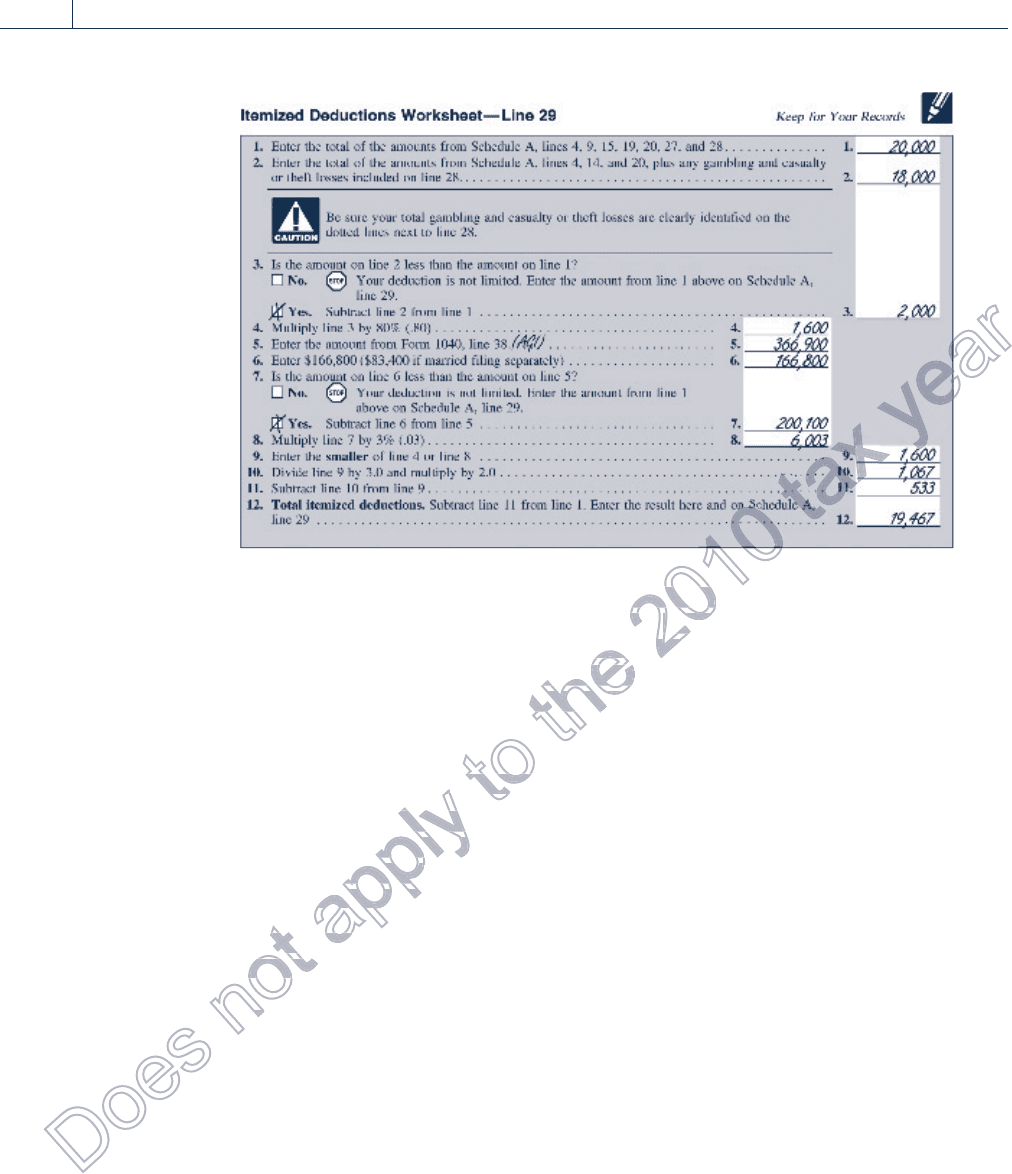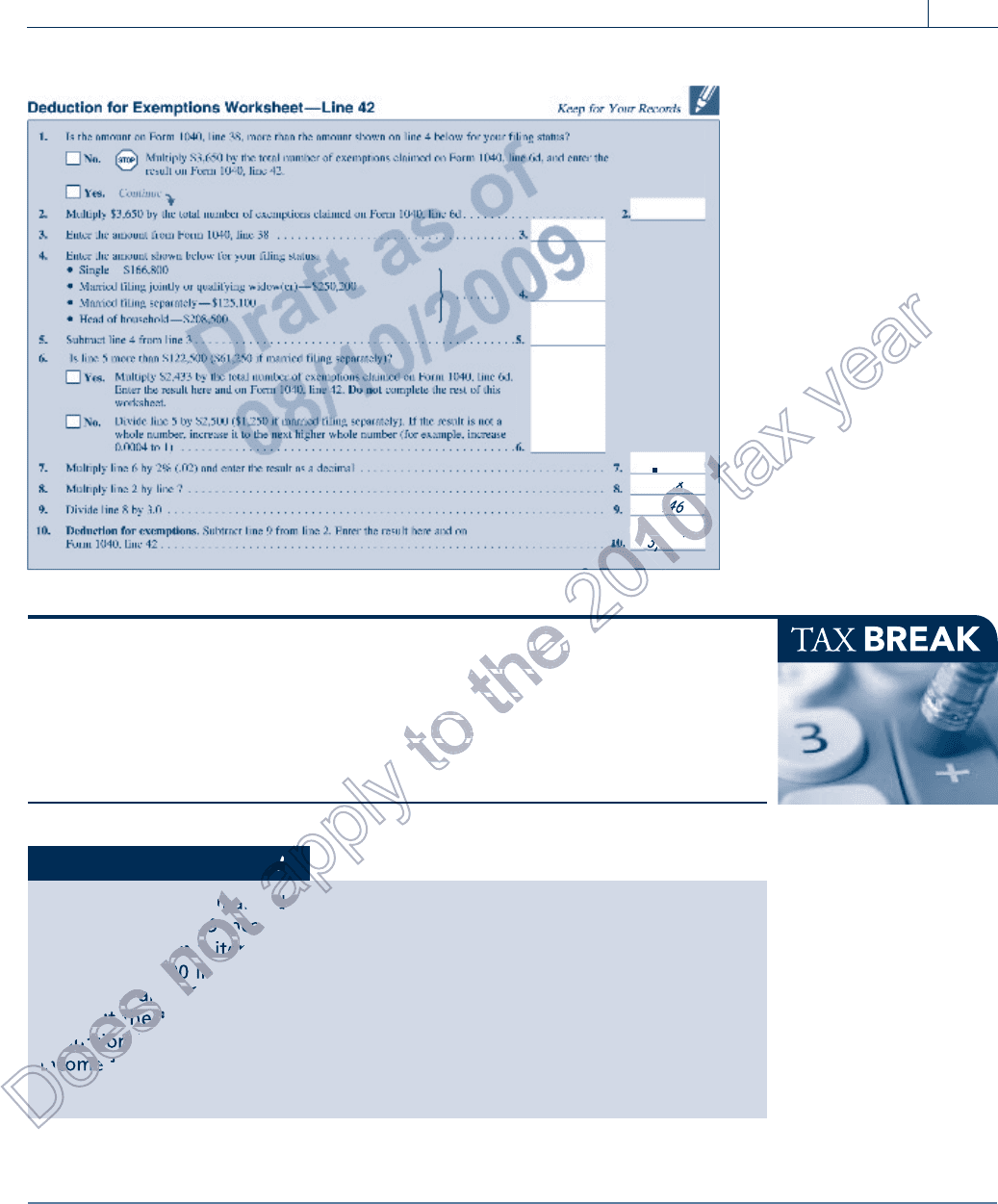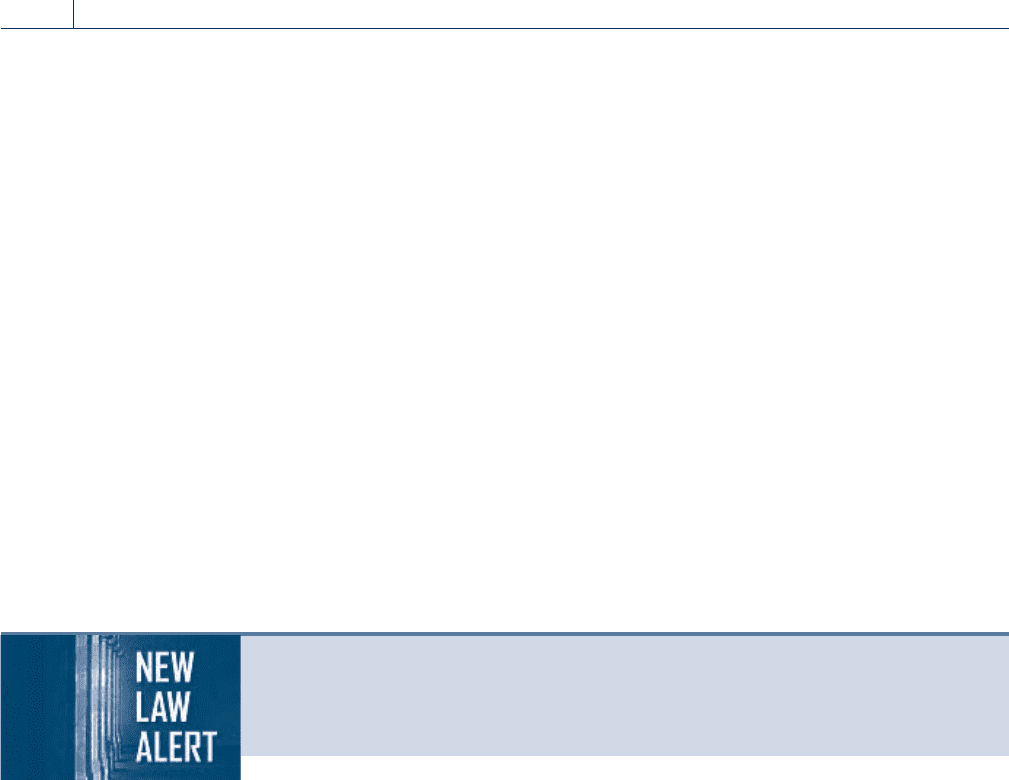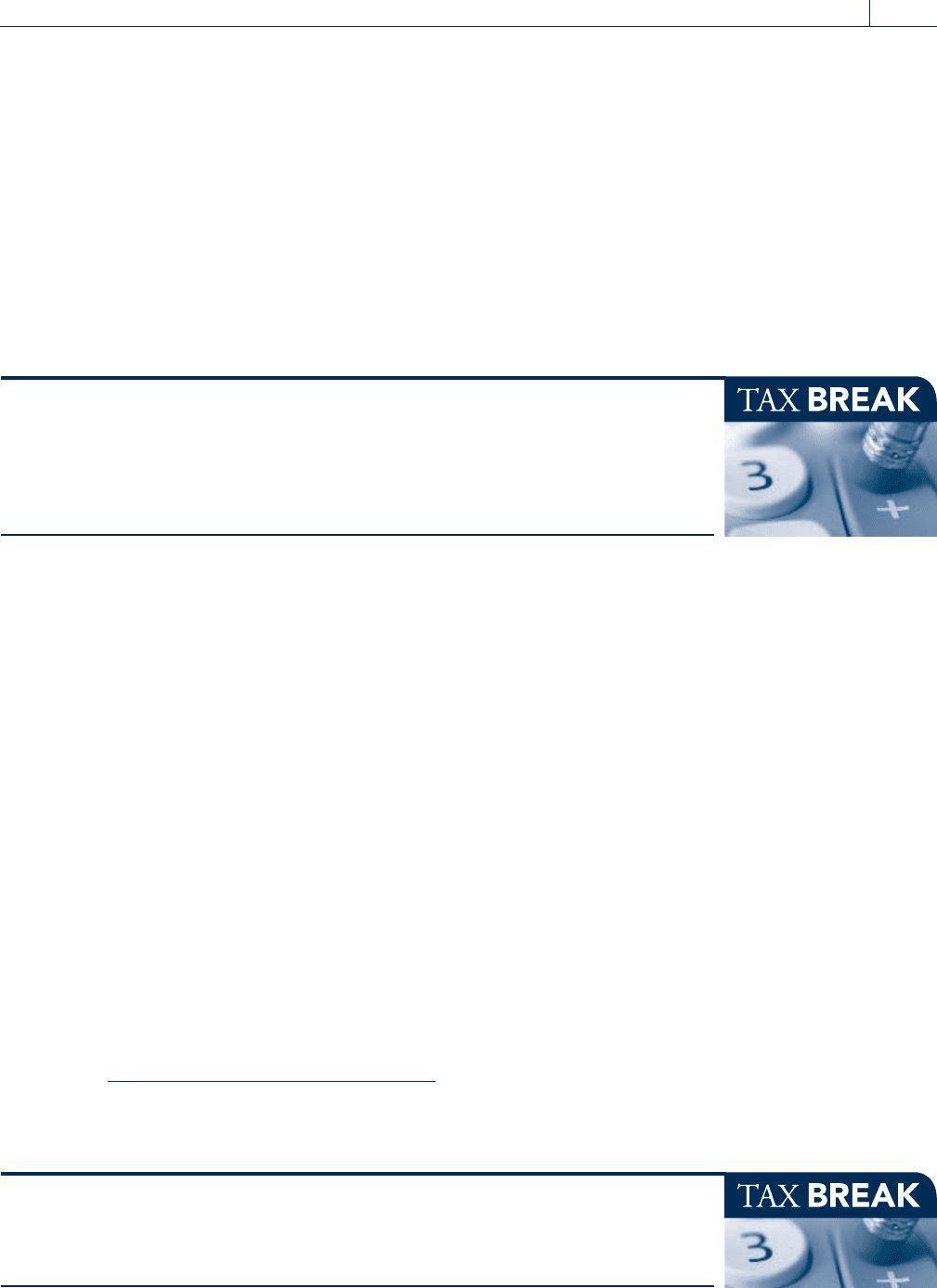Whittenburg Gerald E., Altus-Buller Martha. Income Tax Fundamentals
Подождите немного. Документ загружается.


The 2010 version of the form has not been issued as we go to press.
Section 5.6
Miscellaneous Deductions 5-21
Copyright 2010 Cengage Learning. All Rights Reserved. May not be copied, scanned, or duplicated, in whole or in part. Due to electronic rights, some third party content may be suppressed from the eBook and/or eChapter(s).
Editorial review has deemed that any suppressed content does not materially affect the overall learning experience. Cengage Learning reserves the right to remove additional content at any time if subsequent rights restrictions require it.

5-22 Chapter 5
Itemized Deductions and Other Incentives
Copyright 2010 Cengage Learning. All Rights Reserved. May not be copied, scanned, or duplicated, in whole or in part. Due to electronic rights, some third party content may be suppressed from the eBook and/or eChapter(s).
Editorial review has deemed that any suppressed content does not materially affect the overall learning experience. Cengage Learning reserves the right to remove additional content at any time if subsequent rights restrictions require it.

SECTION 5.7
PHASE-OUT OF ITEMIZED DEDUCTIONS
& EXEMPTIONS FOR HIGH-INCOME TAXPAYERS
Please note: The following section does not apply to the 2010 tax year. The discus-
sion is included in the text because the phase-outs have been part of the tax calcu-
lation for prior years and are expected to return as part of the law for 2011 and
future tax years.
The following sec tion covers the complex calculation of the itemized deduction
and exemption phase-outs for high-inco me individuals as it applied to 2009 tax
returns. Almost all commercial tax software preparation programs calculate the
phase-outs automatically, so few tax preparers actually calculate these by hand.
However, this section will be useful for students wishing to understand how the
phase-outs work and for anyone preparing high-income tax returns by hand.
Limitation on Total Itemized Deductions
In 2009, an individual taxpayer whose adjusted gross income exceeds a threshold amount
must reduce the amount of his or her total itemi zed deductions by 1 percent of the excess
of adjusted gross income over the threshold amount. The threshold amount for 2009 is
$166,800 ($83,400 for married, filing separately). The reduction in the itemized ded u c -
tions is limited to 26
2
/
3
percent of itemized deductions other than the deductions for med-
ical expenses, investment interest expense, casualty and theft losses, and wagering losses
to the extent of wagering gains. Thus, medical expenses, investment interest expense,
casualty and theft losses, and wagering losses are not subject to the o verall limitation.
EXAMPLE Francis and Marcia are married taxpayers who file a joint income tax
return for 2009. In 2009, they have adjusted gross income of $186,850
and itemized deductions of $20,000. The itemized deductions are
from charitable contributi ons and state income taxes. Only $19,799
($20,000 $201) of the itemized deductions are allowed in calculat-
ing taxable income. The reduction in the amount of itemized deduc-
tions claimed by Francis and Marcia is calculated as follows:
Lesser of:
$201 ¼ 1% ($186,850 $166,800), or
$5,333 ¼ 26
2
=
3
% $20,000 N
EXAMPLE Use the same facts as in the preceding example, but assume that
gross income is $366,900, and the itemized deductions consist of
$18,000 in casualty losses (after the $500 floor and after applying the
10 percent of adjusted gross income limitation) and $2,000 in state
income taxes. In 2009, Francis and Marcia may deduct only $19,467
($20,000 $533) of itemized deductions. The reduction in the other-
wise allowable itemized deduction amount is equal to the lesser of
$2,001 (1% [$366,900 $166,800]) or $533 (26
2
/
3
% $2,000). The
reduction in the amount of itemized deductions may also be calcu-
lated using the Itemized Deductions Worksheet provided in the
Form 1040 Instructions, as shown on the next page. N
Personal and Dependency Exemptions
Taxpayers are allowed two types of exemptions: personal and dependency as covered
in Chapter 1. For 2009, each exemption reduces adjusted gross income by $3,650.
Section 5.7
Phase-out of Itemized Deductions & Exemptions for High-Income Taxpayers 5-23
D
o
e
1
e
s
$
s
grogro
$18$18
s
$1
s
8
s
gro
gro
$18
n
e the se the s
ii
n
the
n
e the s
in
o
o
$5,$5,
o
$5
o
3
o
5
$5,3
$5
t
5,33
t
$20$20
333333
t
01
3
t
$2
t
20
$20
333
a
a
1%1%
a
1%
a
%
a
¼
1%
1%
p
FrancFranc
p
is
p
ranc
p
Franci
ranc
p
The reThe re
is anis an
p
ed
and
p
he r
h
p
e
The re
is an
he r
sa
l
iteite
eded
e ite
edu
y
emi
uc
y
nsns
emizemiz
ctct
y
sa
zed
tio
y
ons
mi
ons
temize
ct
t
0,
nd
t
0,00,0
dsds
t
00
t
20
t
ha
h
20,0
dst
o
o
ve adve ad
00. T00. T
o
ea
00
o
Th
o
av
0
o
ve ad
000. T
ead
00 T
t
yer
ust
t
yers wyers w
t
ers
t
t
yers w
t
h
subjecsubjec
ww
h
j
wh
h
subje
subjec
w
e
nvesnves
ct toct to
e
to
e
t
e
ec
e
t
nve
inves
ct to
nve
tt
2
thethe
ses, anses, an
enen
2
the
sses,
m
2
d
an
2
h
the
ses, and
men
0
nd
0
the itthe it
deducdeduc
dd
0
he
dedu
0
ct
0
nt
d
0
he
the it
deduc
d
the i
deduc
1
u
temi
1
ounoun
temiztemiz
1
mo
oun
temiz
0
d
0
of theof the
tfor2tfor2
0
of th
for
0
20
0
t
0
old
of the
tfor2
of th
for
t
m
xce
t
momo
t
mou
t
m
t
amou
xce
a
a
untunt
a
ou
a
nt
a
a
ount
nt
x
y
e
a
r
Copyright 2010 Cengage Learning. All Rights Reserved. May not be copied, scanned, or duplicated, in whole or in part. Due to electronic rights, some third party content may be suppressed from the eBook and/or eChapter(s).
Editorial review has deemed that any suppressed content does not materially affect the overall learning experience. Cengage Learning reserves the right to remove additional content at any time if subsequent rights restrictions require it.

The exemption deducti on may be reduced, but not to less than two-thirds of the $3,650
exemption amount, or $2,433, for high-income taxpayers. If a taxpayer’s adjusted gross
income (AGI) exceeds a certain threshold amount, the exemption deduction is reduced
by one-third of 2 percent for each $2,500 ($1,250 for married taxpayers filing separately)
or fraction thereof by which the taxpayer’s AGI exceeds the threshold amount. The thresh-
old amounts for 2009 are:
Filing Status Threshold Amount
Single $166,800
Married, filing jointly 250,200
Married, filing separately 125,100
Head of household 208,500
The maximum reduction in the exemption deduction is $1,217 per exemption (or one-
third of $3,650).
EXAMPLE In 2009, Heather is a single taxpayer with adjusted gross income of
$180,100. She is entitled to one exemption worth $3,650. Heather’s
exemption must be reduced by $146 (12% $3,650
1
/
3
). The
12 percent is calculated as follows:
1. ($180,100 $166,800) / $2,500 ¼ 5.32, which is rounded up to 6.
2. 2% 6 ¼ 12%, the exemption reduction percentage.
3. The exemption reduction percentage is reduced to one-third of
that amount.
Heather’s allowed exemption amount is $3,504 ($3,650 $146).
The allowed exemption amount may also be calculated using the
Deduction for Exemptions Worksheet provided in the Form 1040
Instructions, as shown on the next page. If Heather had an exemption
for a dependent, this exemption would also be reduced to $3,504. N
5-24 Chapter 5
Itemized Deductions and Other Incentives
D
o
e
s
n
XX
n
EX
n
XA
o
hird ohird o
o
hird
o
o
o
th
o
hird o
hird
t
of
t
TheThe
of $of $
t
he m
f
t
T
t
Th
The
of $
xi
a
HeadHead
aximaxim
a
He
a
i
a
a
a
ead
Head
axim
i
p
rried,rried,
dofhdofh
p
fho
p
ied
of
r
p
ed
rried,
ad of h
ied,
dof
p
d, filind, filin
filinfilin
ouou
p
n
ling
p
fili
filin
,
p
fili
d, filin
, filin
ou
filin
filin
l
ngng
ng j
y
joi
y
oinoin
y
ntl
y
oin
t
t
t
t
t
o
o
o
t
xpxpa
t
p
t
axp
xpa
h
$,$,
payer’s Apayer’s A
h
yer’s
h
$2,50
$2,50
payer’s A
AG
e
damdam
0 ($10 ($1
AGAG
e
($1,2
1
e
00
e
($
da
dam
0 ($1,
AG
0($
2
ut nut n
mm
taxptaxp
untunt
2
ome
ou
2
tax
tn
ut n
m
taxp
unt,
xpa
0
ot toot to
0
ot to
0
le
0
no
0
not to l
xpay
ot to
1
ess
1
1
0
0
0
e
e
e
a
a
a
a
r
Copyright 2010 Cengage Learning. All Rights Reserved. May not be copied, scanned, or duplicated, in whole or in part. Due to electronic rights, some third party content may be suppressed from the eBook and/or eChapter(s).
Editorial review has deemed that any suppressed content does not materially affect the overall learning experience. Cengage Learning reserves the right to remove additional content at any time if subsequent rights restrictions require it.

When total itemized deductions are about the same as the standard deduction
each year, an individual can time the payment of deductions in order to itemize
deductions every other year. A taxpayer usually has discretion over the timing of
property tax payments, charitable contributions, year-end mortgage interest pay-
ments, and certain medical expenses. Shifting the payment of these deductions
to one tax year will result in a larger benefit over a 2-year period than would
otherwise be available.
SECTION 5.8
EDUCATIONAL INCENTIVES
Qualified Tuition Programs (QTP)
A Qualified Tuition Program (sometimes called a Section 529 tuition plan) allows tax-
payers (1) to buy in-kind tuition credits or certificates for qualified higher education
expenses or (2) to contribute to an account established to meet qualified higher education
Self-Study Problem 5.7
Elvis and Greta are married taxpayers who file a joint income tax return for
2009. On their 2009 income tax return, they have adjusted gross income of
$181,000 and total itemized deductions of $12,000. The itemized deductions
consist of $5,000 in state income taxes and a $7,000 casualty loss (after the
$500 floor and after applying the 10 percent of adjusted gross income limita-
tion). Of the $12,000 of itemized deductions, what amount is allowed as a
deduction in calculating taxable income on Elvis and Greta’s 2009 federal
income tax return?
$ ____________
3,650
180,100
166,800
13,300
.12
438
146
3,504
6
X
X
Section 5.8
Educational Incentives 5-25
D
D
i
D
D
D
D
in
o
duc
come
o
o
o
duc
come
com
e
e
Of t
ction
e
e
e
e
Of t
ction
t
Of
tio
s
s
or an
the $
s
s
or an
the $
n
tota
000 in
af
n
n
tota
000 in
af
o
o
09 in
al ite
o
o
o
o
09 in
al item
09 in
l ite
t
t
ma
nco
t
t
t
ma
ncom
a
a
a
a
a
5.7
ed t
a
a
a
a
a
a
a
a
a
a
5.7
ed t
dt
p
p
p
p
p
p
p
p
p
p
p
p
p
p
l
l
y
y
y
y
y
y
y
t
fit
t
tintin
efit oefit o
t
g
to
t
ft
tin
tin
efit ov
ove
o
,,
gthegthe
oveove
o
the
o
e
o
ng
ns,
ns,
gthe
over
the
ove
t
ear
t
hashas
ear-ear-
t
sd
ar
t
h
t
d
a
has
ear-
h
deducdeduc
discrdiscr
h
du
discr
h
a
dedu
deduct
s discre
e
e
e
thethe
ctionction
e
e
ion
e
s
e
s
e
the
e
the s
ctions
the
t
2
2
2
2
2
2
2
an
0
0
0
0
1
3,50
3,50
38
14
438
1
4
14
t
t
t
t
a
x
y
e
a
r
Copyright 2010 Cengage Learning. All Rights Reserved. May not be copied, scanned, or duplicated, in whole or in part. Due to electronic rights, some third party content may be suppressed from the eBook and/or eChapter(s).
Editorial review has deemed that any suppressed content does not materially affect the overall learning experience. Cengage Learning reserves the right to remove additional content at any time if subsequent rights restrictions require it.

expenses. Such Qualified Tuition Programs may be sponsored by a state government or a
private institution of higher learning. Distributions are generally not taxable if the funds
are used to pay qualified higher education expenses. Qualified higher education expenses
include tuition, fees, books, supplies, and equipment required for the enrollment or atten-
dance at an eligible educational institution. In addition, taxpayers are allowed reasonable
room and board costs, subject to certain limitations. The earnings portion of distributions
that are not used for qualified tuition expenses are includable in the distributee’s gross
income under the annuity income rules and are subject to a 10 percent early withdrawal
penalty.
EXAMPLE In 2010, Karen uses in-kind credits of $5,000 that were purchased
through a state qualified tuition program for her son’s college tuition.
The tuition is a qualified higher education expense of the son. There-
fore, the $5,000 distribution will be excluded from Karen’s or her
son’s income. N
EXAMPLE In 2010, Ken uses a distribution from a state QTP of $9,000 (of which
$2,000 is earnings) to pay for his son’s qualified highe r education
expenses. None of the $9,000 is taxable to Ken or his son. N
For 2009 and 2010, qualifying expenses for Section 529 plans include computer
technology such as computers, peripheral equipment, software, Internet access,
and related services. The computer t echnology must be used primarily for
education.
Unlik e Educati onal Savings Accounts, discussed on the next page, there is no income
limit on the amount of contributions to a Qualified Tuition Program. Like an Educational
Savings Account, however, the contributions are not deductible. Any contributions are
gifts, however, and thus subject to the gift tax rules. In addition, most programs impose
some form of overall maximum contribution for each beneficiary based on estimated future
higher education expenses.
EXAMPLE Bill has AGI of $275,000 and has two children. He chooses to contrib-
ute $9,000 (he is allowed to contribute any amount up to the limit
imposed by his state’s law) to a QTP for each of his children in 2010,
even with his high AGI. The $18,000 is not deductible to Bill, but any
earnings on the contribution accumulate tax free and are not taxable
if used for future qualified higher education expenses. N
A taxpayer may claim an American Opportunity credit or lifetime learning credit (dis-
cussed in detail in Chapter 6) for a tax year and exclude from gross income amounts distrib-
uted (both the principal and the earnings portions) from a qualified tuition program on behalf
of the same student. This is true as long as the distribution is not used for the same expenses
for which a credit was claimed. However, the amount of qualified higher education expenses
for a tax year for purposes of calculating the exclusion from income must be reduced by
scholarships, veterans’ benefits, military reserve benefits, employer-provided educational
assistance amounts, and American Opportunity and lifetime learning credits amounts.
5-26 Chapter 5
Itemized Deductions and Other Incentives
Copyright 2010 Cengage Learning. All Rights Reserved. May not be copied, scanned, or duplicated, in whole or in part. Due to electronic rights, some third party content may be suppressed from the eBook and/or eChapter(s).
Editorial review has deemed that any suppressed content does not materially affect the overall learning experience. Cengage Learning reserves the right to remove additional content at any time if subsequent rights restrictions require it.

EXAMPLE In 2010, Sammy receives $15,000 from a qualified tuition program.
He uses the funds to pay for his college tuition and other qualified
higher education expenses. Sammy also claims an American Opportu-
nity credit of $1,500 for the year, based on the same expenses. For
purposes of the QTP exclusion calculation, the $15,000 must be
reduced to $13,500 ($15,000 $1,500). N
The tax law provides that if the total distributions from a qualified tuition program and
from an educational savings account exceed the total amount of qualified higher education
expenses, the taxpayer will have to allocate the expenses among the distributions for pur-
poses of determining how much of each distribution is excludable.
There are billions of dollars invested in the increasingly popular Section 529 Qual-
ified Tuition Programs across the country. The plans offered by different states
vary significantly and it is possible for a taxpayer to invest in the plan of a state
other than the state that he lives in. The following two Web sites offer informa-
tion comparing state plans and answers to questions regarding plan operation:
www.collegesavings.org and www.savingforcollege.com.
Educational Savings Accounts
Taxpayers are allowed to set up educational savings accounts, also known as Coverdell Edu-
cation Savings Accounts, to pay for qualified higher education expenses. The maximum
amount a taxpayer can contribute annually to an educational savings account for a beneficiary
is $2,000. Contributions are not deductible and are subject to income limits. Contributions
cannot be made to an educational savings account after the date on which the designated ben-
eficiary becomes 18 years old. In addition, contributions cannot be made to a beneficiary’s
educational savings account during any year in which contributions are made to a qualified
state tuition program on behalf of the same beneficiary. The educational savings account exclu-
sion for distributions of income is available in any tax year in which the beneficiary claims the
American Opportunity credit or the lifetime learning credit (see Chapter 6), provided the dis-
tribution is not used for the same expenses for which the credit was claimed.
Contributions to educational savings accounts are phased out between AGIs of $95,000
and $110,000 for single taxpayers and $190,000 and $220,000 for married couples who file
a joint return. Like regular and Roth IRAs, contributions must be made by April 15 of the
following year.
EXAMPLE Joe, who is single, would like to contribute $2,000 to an educational
savings account for his 12-year-old son. However, his AGI is $105,000,
so his contribution is limited to $667, calculated as follows:
($110,000 upper limit $105,000 AGI)
$15,000
$ 2,000 ¼ $667 contribution
$15,000 is the spread between the upper and lower phase-out limits. N
For parents with income above the allowable limit, a gift may be made to a child
and the contribution may be made to an educational savings account by the
child. There is no requirement that the contributor have earned income as there
is for IRAs.
Section 5.8
Educational Incentives 5-27
Copyright 2010 Cengage Learning. All Rights Reserved. May not be copied, scanned, or duplicated, in whole or in part. Due to electronic rights, some third party content may be suppressed from the eBook and/or eChapter(s).
Editorial review has deemed that any suppressed content does not materially affect the overall learning experience. Cengage Learning reserves the right to remove additional content at any time if subsequent rights restrictions require it.

Amounts received from an educational savings account are tax free if they are used for
qualified education expenses. Qualified education expenses include tuition, fees, books, sup-
plies, and related equipment for private, elementary, and secondary school expenses as well
as for college. Room and board also qualify if the student’s course load is at least 50 percent
of the full-time course load. If the distributions during a tax year exceed qualified education
expenses, part of the excess is treated as a return of capital (the contributions), and part is
treated as a distribution of earnings. The distribution is presumed to be pro rata from
each category. The exclusion for the distribution of earnings is calculated as follows:
Qualified education expenses
Total distribution
Earnings ¼ Exclusion
EXAMPLE Amy receives a $2,000 distribution from her educational savings
account. She uses $1,800 to pay for qualified education expenses. On
the date of the distribution, Amy’s account balance is $5,000, $3,000
of which are her contributions. Because 60 percent ($3,000/$5,000) of
her account balance represents her contributions, $1,200 ($2,000
60%) of the distribution is a tax-free return of capital and $800
($2,000 40%) is a distribution of earnings. The excludable amount
of the earnings is calculated as follows:
$1,800
$2,000
$800 ¼ $720 (thus, the amount taxable is $80,
or $800 $720).
Amy’s adjusted basis for her savings account is reduced to $1,800
($3,000 $1,200). N
Higher Education Expenses Deduction
Please note: The deduction for higher education expenses is expected to be extended to 2010
by Congress in the final weeks of 2010. Please see the Whittenburg companion Web site
for updated information.
Taxpayers are allowed an ‘‘above-the-line’’ deduction for qualified tuition and related
expenses incurred during the tax year. The deduction will be allowed for qualified tuition
and related expenses for enrollment at an institution of higher education during the tax
year. In addition, the deduction will be allowed for qualified expenses paid during a tax
year if those expenses are in connection with an academic term beginning during the tax
year or during the first 3 months of the next tax year.
EXAMPLE Jerry pays $2,000 for his son’s college tuition in November 2010 for
the spring 2011 term. The spring term starts in January 2011. The
$2,000 is deductible in 2010, even though it is for education provided
in a later tax year. N
The total amount of qualified tuition and related expenses for the higher education
expense deduction must be reduced by certain items. The reduction applies to: (1) exclud-
able interest from higher education savings bonds, (2) excludable distributions from qual-
ified state tuition plans, and (3) excludable distributions from educational savings accounts.
EXAMPLE Matty pays $20,000 in tuition for her children to attend college in 2010.
Included in that amount is $5,000 she received from a qualified state
tuition plan and $3,000 excluded interest from educational saving
bonds. Matty’s qualified tuition expense for purposes of the higher
education expense deduction is $12,000 ($20,000 $5,000 $3,000). N
5-28 Chapter 5
Itemized Deductions and Other Incentives
Copyright 2010 Cengage Learning. All Rights Reserved. May not be copied, scanned, or duplicated, in whole or in part. Due to electronic rights, some third party content may be suppressed from the eBook and/or eChapter(s).
Editorial review has deemed that any suppressed content does not materially affect the overall learning experience. Cengage Learning reserves the right to remove additional content at any time if subsequent rights restrictions require it.

The deduction may not exceed a specified annual amount. The deduction is $4,000 for
single and head of household taxpayers with modified AGI below $65,000 and for married
filing jointly taxpayers with modified AGI below $130,000. The amount is $2,000 for sin-
gle taxpayers with modified AGI between $65,000 and $80,000 and for married joint filers
with modified AGI between $130,000 and $160,000. Taxpayers with AGI exceeding the
limits are not allowed a deduction.
EXAMPLE In 2010, Juan is single and has qualified higher education expenses of
$7,000. His modified AGI is $62,000. He gets a $4,000 above-the-line
deduction. If his modified AGI were $66,000, he would get a $2,000
deduction. N
Self-Study Problem 5.8
a. Abby has a distribution of $10,000 from a qualified tuition program, of
which $3,000 represents taxable earnings. The funds are used to pay for her
daughter’s qualified higher education expenses. How much of the $10,000
distribution is taxable to the daughter?
$ ____________
b.During 2010, Henry (a single taxpayer) has a salary of $85,000 and interest
income of $4,000. Calculate the maximum contribution Henry is allowed for
an educational savings account.
$ ____________
KEY POINTS
Learning Objectives Key Points
LO 5.1:
Understand the nature and treat-
ment of medical expenses.
Taxpayers are allowed a deduction for medical expenses paid for themselves, their spouse,
and their dependents.
Qualified medical expenses are deductible only to the extent they exceed 7.5 percent of a
taxpayer’s adjusted gross income.
Qualified medical expenses include such items as prescription medicines and drugs, insulin,
fees for doctors, dentists, nurses, and other medical professionals, hospital fees, hearing
aids, dentures, eyeglasses, contact lenses, medical transportation and lodging, crutches,
wheelchairs, guide dogs, birth control prescriptions, acupuncture, psychiatric care, medical
insurance premiums, and various other listed medical expenses.
LO 5.2:
Calculate the itemized deduction
for taxes.
The following taxes are deductible: income taxes (state, local, and foreign), sales taxes (by
election in lieu of state and local income tax), real property taxes (state, local, and foreign),
and personal property taxes (state and local).
Nondeductible taxes include the following: federal income taxes; employee portion of Social
Security taxes; estate, inheritance, and gift taxes (except in unusual situations not discussed
here); gasoline taxes; excise taxes; and foreign taxes if the taxpayer elects a foreign tax credit.
If real estate is sold during the year, the taxes must be divided between the buyer and
seller based on the number of days in the year that each taxpayer held the property.
To be deductible, personal property taxes must be levied based on the value of the prop-
erty. Personal property taxes of a fixed amount, or those calculated on a basis other than
value, are not deductible.
Section 5.8
Educational Incentives 5-29
Copyright 2010 Cengage Learning. All Rights Reserved. May not be copied, scanned, or duplicated, in whole or in part. Due to electronic rights, some third party content may be suppressed from the eBook and/or eChapter(s).
Editorial review has deemed that any suppressed content does not materially affect the overall learning experience. Cengage Learning reserves the right to remove additional content at any time if subsequent rights restrictions require it.

LO 5.3:
Apply the rules for an individual
taxpayer’s interest deduction.
Deductible personal interest includes qualified residence interest (mortgage interest), prepay-
ment penalties, investment interest, and certain interest associated with a passive activity.
Nondeductible consumer interest includes interest on any loan, the proceeds of which are
used for personal purposes, such as credit card interest, finance charges, and automobile
loan interest, with the exception of the interest on ‘‘qualified home equity debt’’ used for
these purposes.
Qualified residence interest is the sum of the interest paid on ‘‘qualified residence acquisi-
tion debt’’ plus ‘‘qualified home equity debt.’’
Deductible investment interest is limited to the taxpayer’s net investment income, which is
investment income such as dividends and interest, less investment expenses other than
interest.
LO 5.4:
Determine the charitable contribu-
tions deduction.
To be deductible, the donation must be made in cash or property.
Donations must be made to a qualified recipient.
The following contributions are not deductible: gifts to social clubs, labor unions, interna-
tional organizations, and political parties; contributions of time, service, the use of property,
or blood; contributions where benefit is received from the contribution, for example, tuition
at a parochial school; and wagering costs, such as church bingo and raffle tickets.
For donated property other than cash, the general rule is that the deduction is equal to the
fair market value of the property at the time of the donation.
LO 5.5:
Compute the deduction for casu-
alty and theft losses.
A casualty is a complete or partial destruction of property resulting from an identifiable
event of a sudden, unexpected, or unusual nature. Examples include property damage from
storms, floods, shipwrecks, fires, automobile accidents, and vandalism.
For the partial destruction of business or investment property and the partial or complete
destruction of personal property, the deduction is the decrease in fair market value of the
property, not to exceed the adjusted basis of the property.
For the complete destruction of business and investment property, the deduction is the
adjusted basis of the property.
The amount of each personal casualty loss is reduced by $100 and only the excess over 10
percent of the taxpayer’s adjusted gross income is deductible.
LO 5.6:
Identify miscellaneous itemized
deductions.
Miscellaneous deductions fall into two categories, those limited to the extent the total
exceeds 2 percent of adjusted gross income and those with no limitation.
Examples of items which are not subject to the 2 percent of adjusted gross income limita-
tion are handicapped impairment-related work expenses, certain estate taxes, amortizable
bond premiums, terminated annuity payments, and gambling losses to the extent of gam-
bling winnings.
Common miscellaneous deductions that are subject to the 2 percent limitation include unre-
imbursed employee business expenses and employee business expenses reimbursed under a
nonaccountable plan, investment expenses, tax return preparation fees, union dues, job-
hunting expenses, and professional subscriptions.
LO 5.7:
Understand the basic theory
behind the itemized deduction and
exemption phase-outs for high-
income taxpayers for years prior to
and subsequ ent to 201 0.
In 2009, an individual taxpaye r whose adjusted gross income exceeds a threshold amount
must reduce the amount of his or her total itemized deductions by 1 percent of the excess
of adjusted gross income over the threshold amount.
The 2009 exemption deduction is phased out to a minimum of two-thirds of the $3,650
exemption amount, or $2,433, if a taxpayer has adjusted gross income (AGI) exceeding a
certain threshold amount.
LO 5.8:
Understand the tax implications
of using educational savings
vehicles.
A Qualified Tuition Program (a Section 529 plan) allows taxpayers (1) to buy in-kind tuition
credits or certificates for qualified higher education expenses or (2) to contribute to an
account established to meet qualified higher education expenses. Earnings on the account
are not taxable if the account is used for qualified higher education expenses.
5-30 Chapter 5
Itemized Deductions and Other Incentives
e
ertaertai
D
i
D
rta
D
m
xem
ertai
erta
o
o
pp
ntnt
o
th
o
nt
o
p
o
o
p
nt
nt
e
h
e
onon
hre
hre
e
h
e
on
on a
hre
n
h
s
s
amam
sho
sho
s
sh
am
am
sho
n
un
n
untunt
dd
t
unt
da
o
,
o
,or
,o
o
t
o
t, o
,o
t
r
t
dd
rr
t
d
de
or $
2
a
ducduc
2424
a
ct
4
a
duc
2
d
duct
2,43
24
p
3,
p
tiontion
33,33,
p
o
3
ion
tion
33,
io
33
p
if a
p
nisnis
ifif
is
p
i
nis
if
is
f
l
p
y
ph
t
y
ha
tax
y
phph
tt
y
ph
pha
ta
t
se
t
ss
eded
t
ed
t
es
esh
ed
d
o
do
do
o
do
o
hol
hol
do
do
t
t
t
aa
t
a
a
tt
h
mo
h
momo
h
mo
amo
t
e
untunt
e
e
ount
unt
2
dedded
2
de
2
ded
ded
0
uctuct
0
duc
duct
uc
1
io
1
tio
io
tio
0
sbsb
0
0
s
0
0
c
b
ns b
sb
t
y
t
ee
11
t
e
t
ed
e
y1
a
pepe
a
a
e
a
p
a
1
s
1pe
rc
x
aa
tt
ercerc
x
a
e
x
th
ce
x
t
a
th
erce
y
re
nt
y
h
o
y
resres
tt
y
es
resh
nt
e
f
e
holdhold
ff
e
e
hold
e
ld
hold
ft
hol
a
h
a
dd
aa
a
a
a
a
a
d
a
d
d
am
a
r
mo
r
mm
r
m
Copyright 2010 Cengage Learning. All Rights Reserved. May not be copied, scanned, or duplicated, in whole or in part. Due to electronic rights, some third party content may be suppressed from the eBook and/or eChapter(s).
Editorial review has deemed that any suppressed content does not materially affect the overall learning experience. Cengage Learning reserves the right to remove additional content at any time if subsequent rights restrictions require it.
